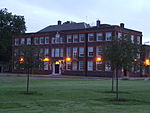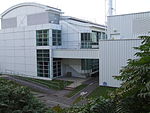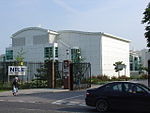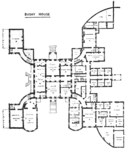- National Physical Laboratory (United Kingdom)
-
National Physical Laboratory
Painting of the National Physical Laboratory in 2009Type Laboratory Proprietor Department for Business, Innovation and Skills Managed by Serco Region Greater London Address Hampton Road, Teddington, England Postcode TW11 0LW Website www.npl.co.uk 51°25′35″N 0°20′37″W / 51.42639°N 0.34361°WCoordinates: 51°25′35″N 0°20′37″W / 51.42639°N 0.34361°W The National Physical Laboratory (NPL) is the national measurement standards laboratory for the United Kingdom, based at Bushy Park in Teddington, London, England. It is the largest applied physics organisation in the UK.
Contents
Description
NPL is an internationally respected centre of excellence in measurement and materials science. Since 1900, when Bushy House was selected as the site of NPL, it has developed and maintained the primary national measurement standards. Today it provides the scientific resources for the National Measurement System financed by the Department for Business, Innovation and Skills. NPL also offers a range of commercial services, applying scientific skills to industrial measurement problems, and manages the MSF time signal.
Teddington was also home to the UK National Chemical Laboratory but this was closed in 1965 and some of its work was transferred to NPL.
NPL cooperates with professional networks such as those of the IET to support scientists and engineers concerned with areas of work in which it has expertise.
A new state-of-the-art laboratory for NPL at Teddington was completed in 2007.
Researchers
- Notable researchers at NPL
-
Louis Essen (right)
Researchers who have worked at NPL include Paul Baran and Donald Davies, who co-invented packet switching in the early 1960s[1]; D. W. Dye who did important work in developing the technology of quartz clocks; Louis Essen, who invented a more accurate atomic clock than those first built in America. Others who have spent time at NPL include Harry Huskey, a computer pioneer; Alan Turing, one of the fathers of modern digital computing who was largely responsible for the early ACE computer design; Robert Watson-Watt, generally considered the inventor of radar, Oswald Kubaschewski, the father of computational materials thermodynamics and the numerical analyst James Wilkinson. H.J. Gough one of the pioneers of research into metal fatigue worked at NPL for 19 years from 1914-38. The inventor Sir Barnes Wallis did early development work there on the "Bouncing Bomb" used in the "Dam Busters" wartime raids. [2] Sydney Goldstein and Sir James Lighthill worked in NPL's aerodynamics division during WW2 researching boundary layer theory and supersonic aerodynamics respectively.
Directors of NPL
- Directors of NPL
- Sir Richard Tetley Glazebrook, 1900–1919
- Sir Joseph Ernest Petavel, 1919–1936
- Sir Frank Edward Smith, 1936-1937 (acting)
- Sir William Lawrence Bragg, 1937–1938
- Sir Charles Galton Darwin, 1938–1949
- Sir Edward Victor Appleton, 1941 (acting)
- Sir Edward Crisp Bullard, 1948–1955
- Dr Reginald Leslie Smith-Rose, 1955-1956 (acting)
- Sir Gordon Brims Black McIvor Sutherland, 1956–1964
- Dr John Vernon Dunworth, 1964–1977
- Dr Paul Dean, 1977–1990
- Dr Peter Clapham, 1990–1995
- Dr John Rae, 1995–2000
- Dr Bob McGuiness, 2000–2005
- Steve McQuillan, 2005–2008
- Dr Martyn Sené, 2008-2009 (acting)
- Dr Brian Bowsher, 2009–Present
Gallery of NPL buildings
- NPL buildings
References
- ^ Stewart, Bill (2000-01-07). "UK National Physical Laboratory (NPL) & Donald Davies". Living Internet. http://www.livinginternet.com/i/ii_npl.htm. Retrieved 2008-05-12.
- ^ Biographical Memoirs of Fellows of the Royal Society
External links
Categories:- 1900 establishments in the United Kingdom
- Alan Turing
- Buildings and structures in Richmond upon Thames
- Metrology
- Standards organizations
- Research institutes in England
- Serco
- Science and technology in London
Wikimedia Foundation. 2010.














